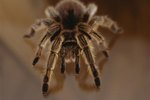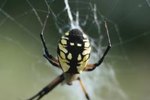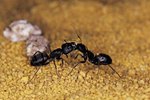
If you've found a spider with bands on its legs, you can breathe a sigh of relief. The most commonly found venomous spiders in the U.S. are the black widow, hobo spider and brown recluse -- none of which have leg bands. Of the leg-banded varieties of spiders, most are completely harmless to people who aren't allergic, and some may be beneficial to humans.
Fishing Spider
These enormous spiders may appear threatening, but their bite is only toxic to people with venom allergies. They can reach a circumference of 3 inches and are brown with darker brown markings. They live near streams and in wooded areas from Canada and the northern United States as far south as Texas.
American House Spider
The brown and tan American house spider is not much larger than a nickel and has a spherical abdomen. Found in small, sticky webs throughout homes and other structures in the U.S. and Canada, it's often mistaken for the poisonous brown recluse, but it may be easily distinguished by the dark stripes across its legs. Its bite is harmless to those who are not allergic to insect bites.
Grass Spider

These quarter-sized brown spiders have distinctive brown or gray stripes and large, finger-like spinning protrusions, called spinnerets, on their abdomens. They're usually found in yards throughout North America, where they build large, funnel-shaped webs. Though at first sight they may resemble the venomous brown recluse, grass spiders are harmless to non-allergic individuals.
Barn Spider

The large barn spider is found in webs attached to outdoor structures in the northeastern U.S. and Canada during late summer and early fall. Classified as an orb-weaver, its round web is geometrically organized into a grid. Its eight eyes, huge round abdomen, brilliant color scheme and fang-like mouth protrusions may make the tan and black barn spider frightening to look at, but its bite is non-venomous, though painful. These spiders feed on pest insects and are therefore considered beneficial to human habitats.
References
Resources
Photo Credits
-
David De Lossy/Photodisc/Getty Images




